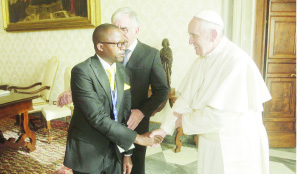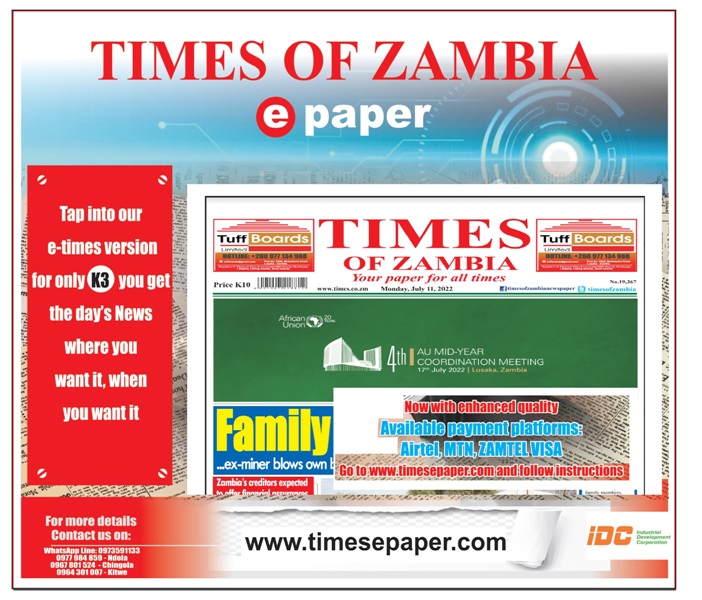
•THE author greets Pope Francis in the apostolic palace at the Vatican. Picture by SALIM HENRY/STATE HOUSE
By CHARLES SIMENGWA –
IT is hard to discuss a visit to Rome without referring to the great civilisations of antiquity which attract thousands of tourists from around the world.
Structures and works of art from the ancient past define Italy’s premier city which, with its cobbled streets, stands out for its architectural superiority.
I wondered how much time and resources were invested in constructing that labyrinth of little streets all around the imposing city.
There was never a shred of doubt in my mind that indeed, Rome was not built in a day. As other visitors have rightly observed, it could take one a lifetime to see all of the beautiful gems that the city has to offer.
I was in a team of Zambian journalists assigned to cover President Edgar Lungu in Italy, where he had some important business engagements, among them a meeting with Food and Agriculture Organisation director-general, José Graziano da Silva, and another one with International Fund for Agricultural Development president, Kanayo Nwanze.
These were crucial international meetings meant to speed up the diversification of Zambia’s economy, which has heavily depended on copper mining for decades.
Mr Lungu was also the guest of Pope Francis at the Vatican, where he further held bilateral talks with the Secretary of State, Cardinal Pietro Parolin.
The boisterous team of journalists was composed of Charles Chisala from the Zambia Daily Mail, Abram Banda, Mwila Nsofu, and Lillian Kalaba from Zambia National Broadcasting Corporation.
Others were Chikumbi Katebe from the Daily Nation, Kennedy Phiri from Muvi TV, and Florence Mwisa and Winfreda Kayuni from ZANIS, led by the versatile Victor Hachimbi, an assistant director at ZANIS.
Our long voyage to Italy on Emirates Airlines included a stop-over in Dubai, in the United Arab Emirates.
We were greeted by very cold weather in Rome, with temperatures hovering around eight degrees Celsius, but the good-natured people at Hotel Resin, our home for a week, made our stay bearable.
Some amiable diplomats and security officials who included chief of protocol John Bulawayo and State House deputy commissioner of police, Chewe Bowa added the extra shine that we needed in the freezing temperature.
I savoured every experience in Rome, especially the evening meals at some nearby restaurants where we mingled with the local people over some sumptuous Italian dishes.
Among some physical features that caught our collective attention were the roads and the flawless public transport system.
If it is not a bus ride, one has the option to get on a train or a tram, which is a passenger vehicle powered by electricity conveyed by overhead cables, and running on rails laid in a public road.
Motorbikes are immensely popular. From where I stand, it makes economic sense to own a motorbike as the traffic on the mostly narrow roads is heavy.
We were quick to note that despite the heavy traffic congestion, there is no road rage as cars glide effortlessly on the wide network of roads in the city.
Nearly all the roads have been paved with cobblestones which allow a road to be heavily used all year long.
It prevents the build-up of ruts often found in dirt roads, and has the additional advantage of not getting muddy in wet weather or dusty in dry weather.
During my stay in the city, arguably one of the most famous destinations in Europe, I marvelled at the sheer beauty of the buildings most of which are made from marble, a hard crystalline metamorphic form of limestone, typically white with coloured streaks which may be polished and is used in sculpture and architecture.
The ancient city’s best preserved monument, the Colosseum and the Piazza del Popolo were among the many historical sites where our faithful tour guide, Franco Tnzi took us in our rented shuttle, a comfortable Mercedes Benz bus.
It took nearly 10 years to build one of the world’s largest public venues, the Colosseum, with heroic arches, columns and windows that stood about 49 metres high and a seating capacity of 50,000, which made this arena so immense and prominent.
Construction of the arena was ordered by Vespasian in A.D. 72 and was inaugurated by Titus in A.D. 80 with combat games involving gladiators and animals.
The Piazza del Popolo is a large urban square in Rome. The name in modern Italian literally means ‘People’s square’, but historically it derives from the poplars after which the church of Santa Maria del Popolo in the northeast corner of the piazza takes its name.
For centuries, the Piazza del Popolo was a place for public executions, the last of which took place in 1826.
Our treasured sight-seeing took us to the Venice Square, which we found teeming with tourists.
The picturesque structure dominating the square is a monument called Vittoriano, dedicated to King Victor Emmanuel II, the first king of a united Italy.
Across the Vittoriano is the Palazzo Venezia, the building that gave the square its name and was built between 1455 and 1464 by Cardinal Pietro Barbo, who went on to become Pope Paul II.
It is one of the oldest civil renaissance buildings in Rome. The palace was used as a papal residence until Pope Pius IV handed the building over to Venice, who used it as their embassy.
In 1916 the Palazzo Venezia was acquired by the Italian government. Benito Mussolini used the building as his headquarters and addressed the people from the palace’s balcony.
Mussolini created the Fascist Party in Italy in 1919, eventually making himself a dictator prior to World War II. He was killed in 1945.
Our team was treated to more breathtaking sights such as the impressive Roman Forum.
From the entrance on Via dei Fori Imperiali, one can take in the spectacular views of the ancient ruins and relics left behind from the stomping grounds of Rome’s former emperors.
The site started off as a simple valley between the Capitoline and Palatine Hills. It later became the heart of the city’s most important municipal buildings and a commercial centre.
With the limited time on our hands, it was obviously not possible to see other places of note, but for the whole morning allocated to our sight-seeing, and the patient, soft-spoken tour guide on our side, we were lucky to take in just as much.
One lingering lesson from my visit to Rome is the preservation of historical sites which are carefully meshed with modern structures.
Magnificent Vatican
We had a once-in-a-lifetime chance to visit the Vatican, the seat of the Roman Catholic Church whose awesome structures represent superlative pieces of skill.
Pilgrims and tourists from all around the world were swarming into St Peter’s Square, where the Holy Father addresses the Catholic faithful, as others soaked in the might of the Holy See.
As we were to learn from some Vatican officials, many return to their homes without ever seeing the Pope.
It was thus a great honour for me to enter the apostolic palace, which is the official residence of the Holy Father, and to shake hands with Pope Francis in his private library.
St Peter’s Basilica, which we were privileged to tour in the company of President Lungu’s delegation, is simply a masterpiece.
Commonly referred to as the ‘mother of all churches’, the basilica is built on Vatican Hill, across the Tiber River from the historic centre of Rome.
It was commissioned in 324 AD by Constantine as a church to be dedicated to the Apostle Peter.
The church was reportedly built on the burial site of this most influential Christian, who died a martyr and was buried in 64 AD.
The original church was destroyed in the 16th century, and the present structure was built on the same site.
Parisians, pets and jogging
After the tour of duty in Italy, we departed from Fiumicino Airport in Rome using Air France to Charles de Gaulle International Airport in Paris.
We had a tight schedule in Paris where President Lungu was a special guest of French President François Hollande.
He also had crucial meetings with French investors who are keen to partner with Zambian businesses in moving the country’s economy forward.
If we thought Rome was cold, we were in for a shock as the temperature in Paris was as low as three degrees Celsius.
However, this did not affect our morale as we marvelled at some iconic features of the French Capital, such as the Eiffel Tower, a wrought iron lattice tower on the Champ de Mars.
It is named after the engineer Gustave Eiffel, whose company designed and built the tower.
We also entered the Élysée Palace, which is the official residence of the President of the French Republic since 1848.
Dating back to the early 18th century, it contains the office of the President and the meeting place of the Council of Ministers.
We had some good laughter after noticing how many Parisians – inhabitants of Paris – love taking their pets for walks.
Apart from allowing the animals to exercise, the dog owners treasure the benefits that come with regular walks.
One Parisian told us that spending time with your pet is extremely important. It strengthens the bond between you and leads to a strong, trusting relationship.
Regular walks can be extremely beneficial to a pet’s digestive system, and they can help in relieving constipation.
We also noted that despite the forbidding temperatures – by our standards – a good number of Parisians love jogging, obviously to keep fit and for other health reasons.
I may have come down with severe flu upon my return from the marathon tour of Italy and France, which my doctor attributed to the drastic change in the weather, but such could never take away anything from my enduring memories of those beautiful places.






